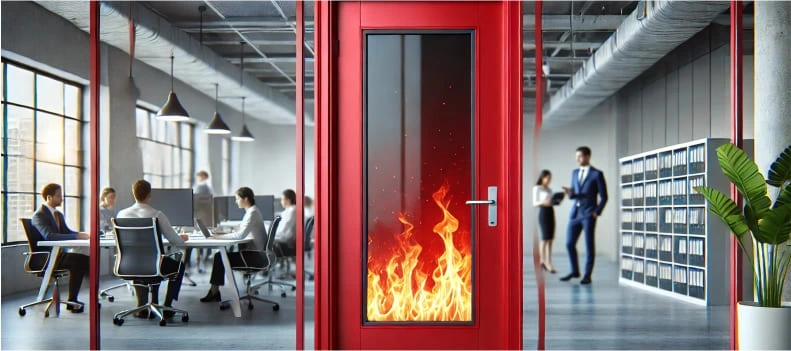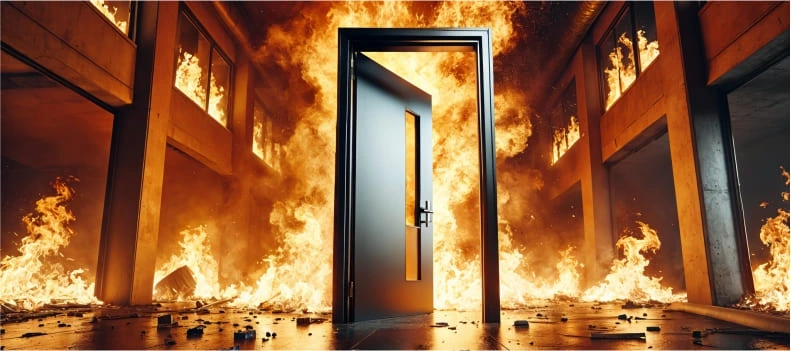Why Choosing the Right Fire-Rated Door Matters
Picture this: A fire breaks out in a building, and in the chaos, a fire-rated door stands firm—buying time, saving lives, and preventing property damage. It’s not just a door; it’s a lifeline. If you’re planning to install or upgrade fire rated doors, making the right choice isn’t just about compliance—it’s about protection, durability, and peace of mind.
In this comprehensive guide, we’ll walk you through everything you need to know about fire-rated doors. Whether you’re a business owner, contractor, or property manager, by the end of this blog, you’ll be able to make an informed decision.
What Are Fire-Rated Doors?
A fire-rated door is not your average door. It’s specifically designed to withstand fire for a set period, usually ranging from 30 minutes to 3 hours. These doors act as barriers, preventing fire and smoke from spreading to other areas, and providing crucial time for evacuation and firefighting.
Key Features of Fire-Rated Doors
- Fire Resistance Duration: Indicates how long the door can withstand fire (e.g., 60 minutes, 90 minutes).
- Intumescent Seals: Expand when exposed to heat, sealing gaps to prevent smoke and fire spread.
- Core Material: Typically made of steel, gypsum, or insulated materials with fire-resistant properties.
- Certifications: Tested under stringent fire safety standards like UL, BS, or NFPA.
Why Are Fire-Rated Doors Essential?

- Life Safety:
During a fire emergency, every second counts. Fire-rated doors slow down the spread of fire, giving occupants more time to evacuate safely. - Property Protection:
By containing fire in one section, these doors reduce the risk of extensive damage to your building. - Regulatory Compliance:
Building codes often mandate fire-rated doors for specific areas like stairwells, corridors, and exits. - Insurance Benefits:
Installing certified fire-rated doors can lower insurance premiums, as they demonstrate proactive fire safety measures.
How to Choose the Right Fire-Rated Door for Your Building
1. Understand Your Building’s Needs
Different buildings have different requirements. For example:
- Residential Buildings: Often require 30-60 minute fire-rated doors for apartment entries.
- Commercial Spaces: Need doors with higher fire resistance for stairwells, server rooms, and main exits.
- Industrial Facilities: Require robust fire-rated doors that can withstand heavy usage and extreme conditions.
2. Check Compliance with Local Regulations
Fire safety codes vary by location. Familiarize yourself with the standards in your area, such as:
- NFPA 80 (USA)
- BS 476 (UK)
- IS 3614 (India)
Choosing doors certified under these standards ensures compliance and reliability.
3. Material Matters
The material of your fire-rated door significantly affects its durability and functionality:
- Steel: Durable, low-maintenance, and resistant to impact and fire.
- Insulated Materials: Lightweight and highly effective at resisting heat transfer, these materials enhance fire resistance and thermal performance.
- Glass: Fire-rated glass panels combine safety with visibility and natural light.
4. Fire Resistance Rating
Choose a door with the appropriate fire resistance rating based on its location. For example:
- 30-minute doors for internal partitions.
- 90-120 minute doors for exits and staircases.
5. Consider Additional Features
- Smoke Seals: To prevent smoke infiltration.
- Vision Panels: For visibility in high-traffic areas.
- Soundproofing: Ideal for offices or residential buildings requiring noise control.
Common Myths About Fire-Rated Doors
Myth 1: Fire-Rated Doors Are Ugly
Reality: Modern fire-rated doors come in sleek designs, with options for glazing and customizable finishes to blend seamlessly with interiors.
Myth 2: Fire-Rated Doors Don’t Need Maintenance
Reality: Regular inspections are essential to ensure seals, hinges, and the core material remain functional.
Myth 3: All Doors Are the Same
Reality: Fire-rated doors undergo rigorous testing and certifications, unlike standard doors.
Maintenance Tips for Fire-Rated Doors
Keeping your fire-rated doors in top condition is critical. Here’s how:
- Inspect the intumescent seals for damage or wear.
- Check hinges and hardware for rust or looseness.
- Test the door’s self-closing mechanism regularly.
- Schedule professional inspections annually.
Where to Install Fire-Rated Doors

- Stairwells and Corridors: Prevent fire from spreading to evacuation routes.
- Boiler Rooms: Contain potential fire hazards.
- Kitchens: Especially in commercial spaces like restaurants.
- Server Rooms: Protect critical infrastructure from fire damage.
Why KORINDIA Is Your Trusted Fire-Rated Door Partner
At KORINDIA, we specialize in fire-rated doors that combine safety with style. Our products are:
✔️ Certified under global fire safety standards.
✔️ Available in customizable designs and finishes.
✔️ Backed by over 42 years of expertise in the industry.
FAQs About Fire-Rated Doors
- How often should fire-rated doors be inspected?
Fire-rated doors should be inspected annually or more frequently in high-use areas. - Can fire-rated doors include glass panels?
Yes, fire-rated glass panels are available and meet the same safety standards. - Are fire-rated doors soundproof?
Many fire-rated doors come with soundproofing options, ideal for offices and homes.
Conclusion: Choosing the Right Fire-Rated Door
Fire-rated doors are an investment in safety, compliance, and peace of mind. By understanding your building’s needs, complying with regulations, and choosing the right materials and features, you can protect lives and property effectively.
Ready to upgrade your fire safety? Contact KORINDIA today for expert guidance and top-quality fire-rated door solutions.


Best Door Solutions for High-Traffic Areas